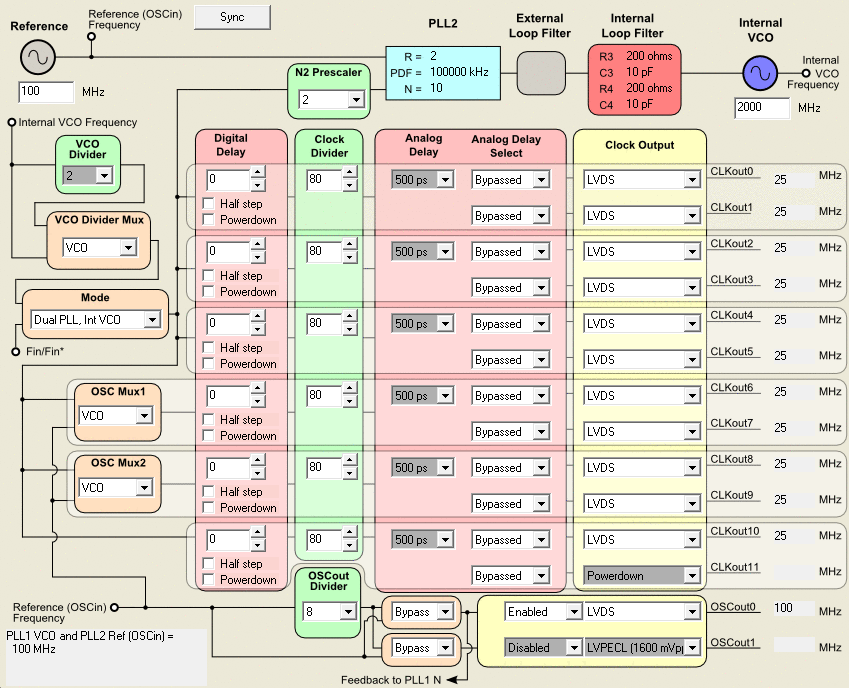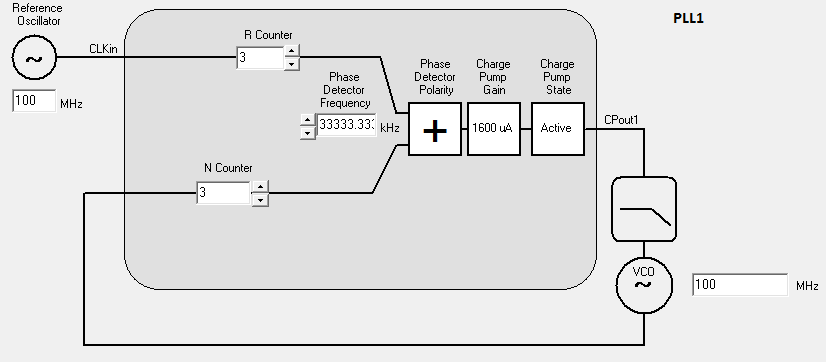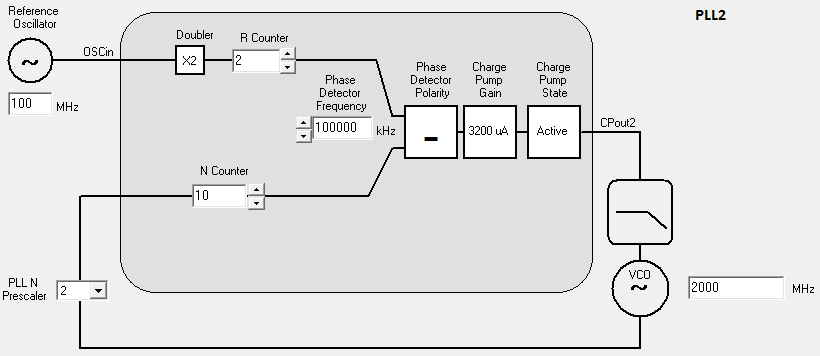This is an old revision of the document!
Table of Contents
Introduction
CoBo uses TI's LMK04800 family of Low-Noise Clock Jitter Cleaner with Dual Loop PLLs. In Cobo 0.2v and CoBo 1.0v LMK04803B is used. The internal VCO of the PLL is designed to run at 2 GHz in our application.
CoBo LMK04803B PLL is responsible for receivering the Global Master Clock (GMC) from Mutant via the MicroTCA backplane on CLK3. After receiving the “dirty” GMC clock the LMK04803B attempts to clean the jitter and lock the clock in order to generate multiple clocks.
There are two clock inputs and 12 outputs for CoBo's LMK04803B. The 1st input is CLKin0 which is connected to the GMC clock. There is some feedback logic that sits in between the LMK04803B and Mutants GMC buffer. The additive jitter of that logic is described here. The 2nd input is CLKin1, in CoBo 0.2v this is connected to MCH clock. However, in CoBo 1.0v a backup local oscillator is used instead. Therefore, by using CLKin1 with a local oscillator, it is possible for CoBo 1.0v to use the local 100MHz clock as a back up clock in case GMC doesn't exist or if you want to run CoBo in standalone mode.
The 12 clock outputs are CKWs and CKRs for Asads and CoBo's FPGA (10 clocks), a buffered version of the VXCO clock, and a programmable clock.
CKR and CKW
CKR and CKW are AGET chip Read and Write clocks. These clocks are passed from LMK04803B to an LVDS buffer on CoBo and sent over VHDCI cables to Asads. We have tested the communication with a 10 meter VHDCI cable with CKW running at 100MHz. The table below lists the trace lengths on the PCB. AS* are the signals from the LMK04803B to the LVDS buffer, CK* (shorter traces) are the signals from the LVDS buffer to the VHDCI connector.
| Name | Node Count | Routed (mil) | |
|---|---|---|---|
| AS0_CKR_N | 2 | 6940.808 | |
| AS0_CKR_P | 2 | 6940.416 | |
| AS0_CKW_N | 2 | 6886.032 | |
| AS0_CKW_P | 2 | 6885.735 | |
| AS1_CKR_N | 2 | 6944.301 | |
| AS1_CKR_P | 2 | 6948.342 | |
| AS1_CKW_N | 2 | 6897.755 | |
| AS1_CKW_P | 2 | 6896.847 | |
| AS2_CKR_N | 2 | 6958.892 | |
| AS2_CKR_P | 2 | 6956.581 | |
| AS2_CKW_N | 2 | 6895.987 | |
| AS2_CKW_P | 2 | 6898.616 | |
| AS3_CKR_N | 2 | 6938.05 | |
| AS3_CKR_P | 2 | 6943.109 | |
| AS3_CKW_N | 2 | 6902.934 | |
| AS3_CKW_P | 2 | 6892.022 | |
| CKR_1_N | 2 | 1331.634 | |
| CKR_1_P | 2 | 1331.632 | |
| CKR_2_N | 2 | 1300.127 | |
| CKR_2_P | 2 | 1302.286 | |
| CKR_3_N | 2 | 1331.444 | |
| CKR_3_P | 2 | 1318.534 | |
| CKR_4_N | 2 | 1299.578 | |
| CKR_4_P | 2 | 1302.145 | |
| CKW_1_N | 2 | 2222.98 | |
| CKW_1_P | 2 | 2228.041 | |
| CKW_2_N | 2 | 2193.289 | |
| CKW_2_P | 2 | 2191.66 | |
| CKW_3_N | 2 | 2228.182 | |
| CKW_3_P | 2 | 2226.657 | |
| CKW_4_N | 2 | 2193.402 | |
| CKW_4_P | 2 | 2191.547 | |
It is possible to change the frequency of CKR/CKW using getEccClient or GetController. Currently, CKR is fixed at 25 MHz. CKW can be programmed to any frequency within the specs of the LMK04803B and the AGET chip.
Synchronization
To synchronize the LMK04803B clocks on a single CoBo board, one has to send a pulse (positive pulse, see datasheet for the minimum length of this pulse) from the FPGA to the LMK04803B chip using PLL_SYNC signal on pin F8. The length of the PCB trace is 1320.475 mils.
The default configuration requires the Mutant and the CoBo to calibrate the GMC/WSCA links between them first. After that the Mutant sends a SYNC command to all CoBos on the WSCA line. CoBo uses that command to sync its own clocks.
PLL Configuration
The default configuration of the PLL is
0x00000A00 0x00000A01 0x00000A02 0x00000A03 0x00000A04 0x00000A05 0x11110006 0x11110007 0x01110008 0x55555549 0x9140410A 0x0400000B 0x0B0C006C 0x1B12902D 0x1200000E 0x8000800F 0x01550410 0x000000D8 0x01010019 0xAFA8001A 0x1C0000DB 0x002000DC 0x0180015D 0x0200015E 0x001F001F
The settings for this configuration are depicted in the figures below
Frequency Accuracy
It is possible to program LMK04803B to lock on certain conditions. Take a look at section 9.6 in the datasheet.
From (3) for PLL1, the frequency accuracy is:
PLL1_ppm = 2e6 * PLL1_WND_Size * Fpd1 / PLL1_DLD_CNT
The default values are:
PLL1_WND_Size is 40 ns
PLL1_DLD_CNT is 1024
Fpd1 = 33.333 MHz
PLL1_ppm = 2e6 * 40e-9 * 33.333e6 / 1024 = 2604.141
If the GMC clock supplied by Mutant doesn't meet PLL1_ppm then PLL1 will not lock to this frequency. PLL1 not locking causes timestamp issues in the data. The user must change the values of PLL1_WND_SIZE and PLL1_DLD_CNT if they want to restrict GMC to smaller ppm values.
For the second PLL:
PLL2_WND_Size is 3.7 ns
PLL1_DLD_CNT is 8192
Fpd2 = 100 MHz
PLL2_ppm = 2e6 * 3.7e-9 * 100e6 / 8192 = 90.33




